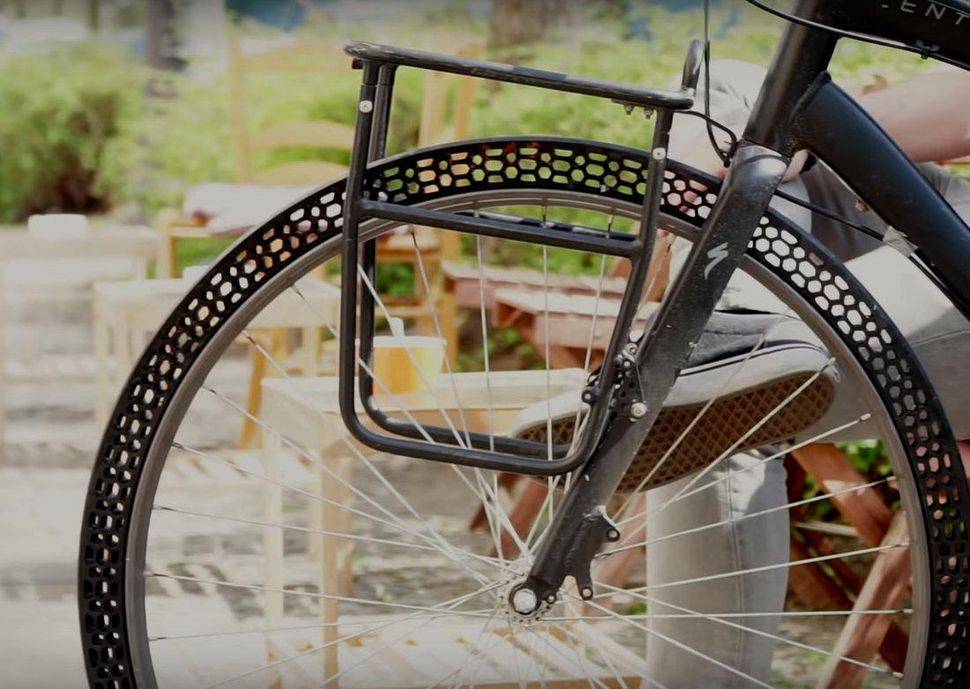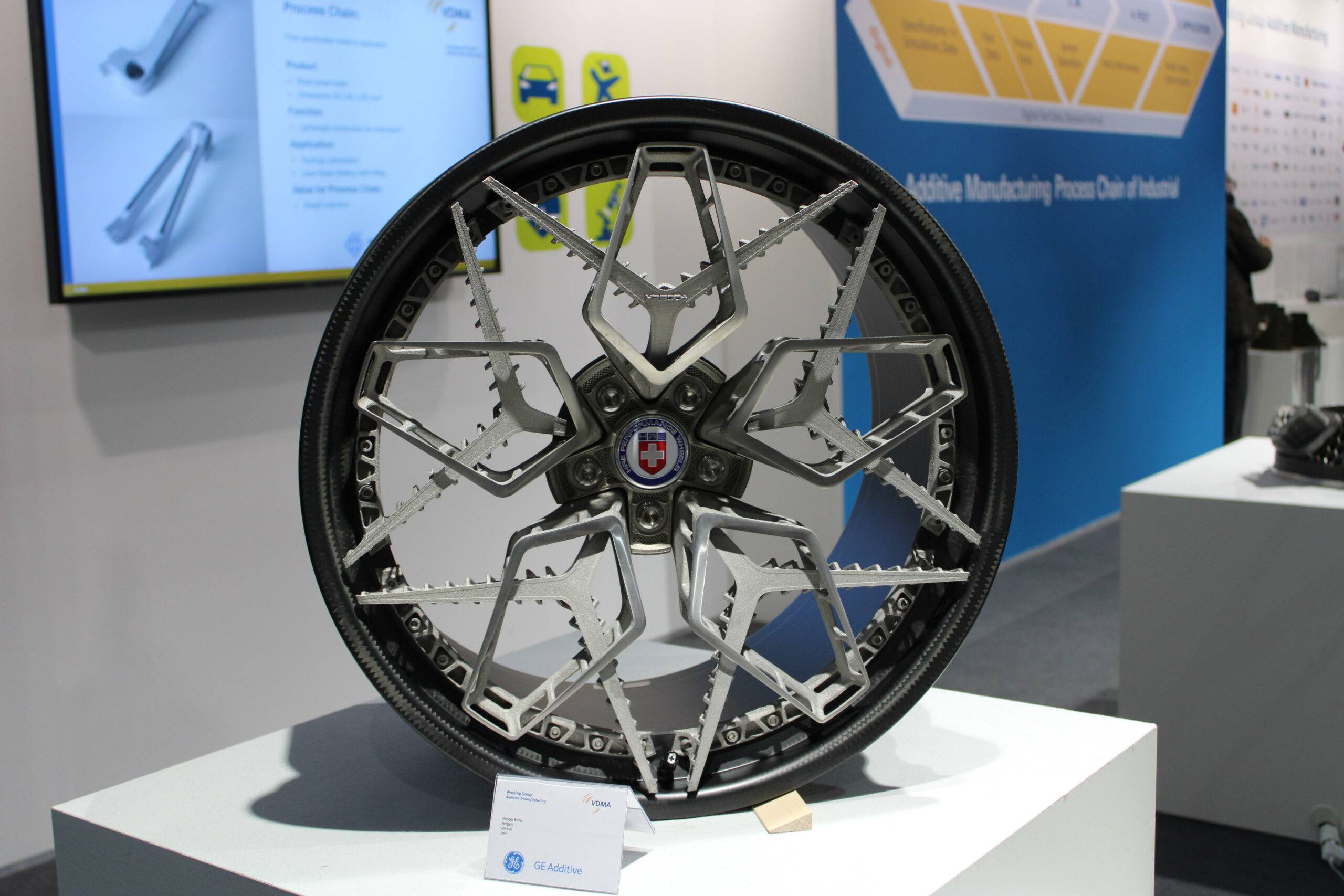Additive manufacturing is eating its way up into the automotive sector. The development has come to such an extent that 3D printed car is longer a dream. The prototyping bubble to which AM was restricted to has broken and burst. Transportation is one of the most important aspects of everyday life across the globe. An unexplored value chain in the automotive industry is the wheel and related solutions.
At formnext 2018, a certain 3D printed wheel gained lot of attention. It was a concept tyre put up as exhibit by HRE wheels, a luxury and sports vehicle wheel manufacturer. The wheel got rolled out as a result of partnership between GE additive and HRE wheels. The wheel was 3D printed with Arcam Electron Beam Melting (EBM) machines. Generally Aluminium wheels are machined leading to material wastage. The wheel named as Byzantine is composed of seven separate parts including five spokes, a carbon fiber rim, and a centerpiece. Titanium has properties like weight, specific strength and corrosion résistance. There have been many concepts of wheels going around.
An overview of innovative 3D printed tyre projects:

Michellin is working on the development of a tyre using rubber, made of organic and recyclable materials. Named as “Vision”, it is an eco-friendly solution but an improved form of tyre. This concept tyre is airless, connected, rechargeable, customizable and organic. It is a wheel and a tyre. Vision combines 4 innovations. It is made of organic material hence reducing the carbon footprint. It is rechargeable according to wear and mobility needs. The tyre has a strong interior architecture ensuring the solidity of the wheel and thus guaranteeing both comfort and safety. Vision can neither explode nor blowout. It is a connected tyre equipped with sensors giving information about its condition.
3D printed airless tyres by BigRep
Bigrep’s newly developed tyre is the world’s first 3D-printed full-scale airless bicycle tyre. It is a see through design. Printed on the BigRep ONE large-scale 3D printer, the tyre prototype utilizes the full potential of BigRep’s new filament called as Pro FLEX. The prototype designed was found to offering smooth ride. Since it is custom built, the tyre can be changed according to user needs, thanks to 3D printing.

The GOODYEAR tyre
The car tyre project launched by Goodyear is called Oxygene. The concept consists of a manufacturing concept that is compliant to eco friendliness. Its raw material comprises of rubber powder and old used tyres. The 3D printing technology employed in manufacturing is selective laser sintering. The little inlets that can be seen in the tyre have been specially designed to contain moss, in order to absorb equal moisture from the road through the tread. This process also releases fresh oxygen through photosynthesis.

The old saying “reinventing the wheel” is used when someone is merely doing what has already been done. The 3D wheel examples above demonstrate that even the wheel can be reinvented and in a very effective way. The future is bright and 3D printer can be the game changer in the following ways:
- Eco friendly solution
The tyre concepts developed have been complying to eco friendliness. In automotive industry one of the main worry is this. The huge investments and developments in electric cars is an example to address the issue. The 3D printed tyres can be a solution for reduced carbon footprints and the material used to print can be from old worn out tyre. Smarter, greener infrastructure and transport will be crucial in addressing the most pressing challenges of urban mobility and development.
- Online monitoring of a tyre can be done by embedding sensors onto it. By incorporating an onboard 3D printing system, it is possible to replace the worn out layers.
- A lighter wheel can be developed from a strong composite material thereby lowering energy used up when it is in motion. This leads to fuel economy and less wear and rear on the tyre
- The number of parts involved in the entire structure of a wheel can be reduced.
- The advantage of 3D printing is the material options. Rather than natural rubber, tyres can be made from wide variety of rubber like material. A tyre made of thermoplastic polyurethane material instead of rubber and has a higher resistance to heat and lower rolling resistance than standard rubber tyres.
- 3D printing eliminates the need to make a tyre mold and made the entire process faster while at a lower cost.
- Rims and hub cabs of a wheel can be 3D printed. Complex profiles can be printed make it possible to have optimized designs that are compatible in different environments. It would be possible to 3D print end-use hubcaps in plastic and coated to achieve a metallic effect.
- Carbon that has developed CLIP process that provides ability to rapidly 3D print structures in a variety of resin-based materials. Carbons process facilitates possibility of mesh generation which enables a product designer to easily create designs for complex grid structures that would otherwise be impossible to manufacture. Tyres fail, if air seals are compromised by the wear that happens to them. Tyres have to be frequently replaced. The geometry of the internal structure could be optimized to handle various situations.
- A 4D design in a tyre would even permit the performance characteristics to vary depending on the situation. For example, as the RPM of the tyre increases, it may reconfigure itself for optimum high speed performance, or shift strength elements to one side during a high speed turn.
- AM has been making strides into large volume manufacturing either by improving the build speed, size or using multiple energy sources in machines. The recent example is that of EOS using nearly a million lasers to process materials. It would be interesting to see wheel like polymers being processed.
With 3D printing scaling up with respect to speed and size, the wheel and related solution value chain will be explored much more in coming years.


